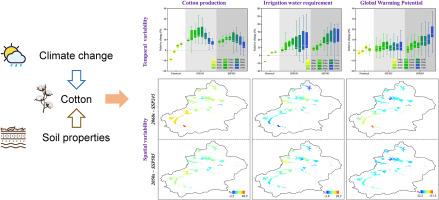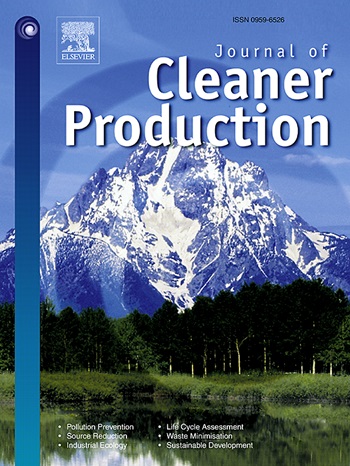未来的气候变化将加强棉花生产,但也会带来巨大的环境成本——APSIM模型对新疆的关注
IF 9.7
1区 环境科学与生态学
Q1 ENGINEERING, ENVIRONMENTAL
引用次数: 0
摘要
评估气候变化对棉花生产、用水量和碳排放的潜在影响对于减少水资源配置和碳排放至关重要,特别是在中国干旱缺水的棉花主产区新疆。本研究利用基于过程的作物模型农业生产系统模拟器(APSIM)对新疆棉花产量、耗水量(ET)、灌溉需水量(IWR)、灌溉水分生产力(IWP)、全球变暖潜势(GWP)和温室气体强度(GHGI)的时空变化进行了模拟,并估算了北疆(NXJ)和南疆(SXJ)棉花产量、需水量和碳排放总量。结果表明,SSP245处理下新疆皮棉产量受益于升温和CO2水平的提高,在20世纪60年代达到峰值2334 kg/ha(比历史时期高14.1%),而SSP585处理下CO2水平升高的积极影响被快速升温所抵消,在21世纪50年代达到峰值2219 kg/ha(比历史时期高11.6%)。与1981 ~ 2020年相比,到2050 ~ 2060年,SSP245和SSP585条件下的IWR、GWP和GHGI分别增长了4.3 ~ 5.6%、38.5 ~ 41.6%和25.1 ~ 25.8%,给新疆水资源和碳减排带来了巨大挑战。到本世纪中后期,新疆省棉花产量将达到287 - 324万吨,超过新疆(55.1-56.2%),但灌溉成本将比新疆省多0.76-0.92亿m³,GWP将比新疆省多0.28-0.59万吨CO2当量。这些结果表明,未来新疆棉花生产将受到水资源和环境压力的限制,特别是在20世纪60年代以后,控制所有行业的碳排放和减缓全球变暖进程将有助于棉花的可持续发展。本文章由计算机程序翻译,如有差异,请以英文原文为准。


Future climate change will strengthen cotton production but have substantial environmental costs—A focus on Xinjiang by APSIM modelling
Assessing the potential impacts of climate change on cotton production, water consumption and carbon emissions is crucial for reducing water allocations and carbon emissions, especially in Xinjiang, a major cotton-producing region of China with an arid climate and water scarcity. In this study, we used the process-based crop model Agricultural Production Systems sIMulator (APSIM) to simulate the spatial and temporal variability of cotton yield, water consumption (ET), irrigation water requirement (IWR), irrigation water productivity (IWP), global warming potential (GWP), and greenhouse gas intensity (GHGI) in Xinjiang, and to estimate the total amount of cotton yield, water demand, and carbon emissions in North Xinjiang (NXJ) and South Xinjiang (SXJ). The results showed that the lint cotton yield in Xinjiang benefited from elevated temperature and CO2 levels under SSP245 and peaked at 2334 kg/ha in the 2060s (14.1% higher than that in the historical period), while the positive effect of elevated CO2 levels was eliminated by the rapid increase in temperature under SSP585 and peaked at 2219 kg/ha in the 2050s (11.6% higher than that in the historical period). Compared with their levels in 1981–2020, the IWR, GWP, and GHGI increased by 4.3–5.6%, 38.5–41.6%, and 25.1–25.8%, respectively, by the 2050s–2060s under SSP245 and SSP585, thus posing great challenges for water resource and carbon emission reductions in Xinjiang. Cotton production in SXJ would reach 2.87–3.24 million tons, dominating that in Xinjiang (55.1–56.2%) by the middle to end of this century but would cost 0.76–0.92 billion m³ more for irrigation and 0.28–0.59 million tons CO2 eq more for GWP than in NXJ. These results suggest that future cotton production in Xinjiang will be limited by water and environmental pressures, especially after the 2060s, and that controlling carbon emissions in all industries and slowing the warming process will contribute to the sustainable development of cotton.
求助全文
通过发布文献求助,成功后即可免费获取论文全文。
去求助
来源期刊

Journal of Cleaner Production
环境科学-工程:环境
CiteScore
20.40
自引率
9.00%
发文量
4720
审稿时长
111 days
期刊介绍:
The Journal of Cleaner Production is an international, transdisciplinary journal that addresses and discusses theoretical and practical Cleaner Production, Environmental, and Sustainability issues. It aims to help societies become more sustainable by focusing on the concept of 'Cleaner Production', which aims at preventing waste production and increasing efficiencies in energy, water, resources, and human capital use. The journal serves as a platform for corporations, governments, education institutions, regions, and societies to engage in discussions and research related to Cleaner Production, environmental, and sustainability practices.
 求助内容:
求助内容: 应助结果提醒方式:
应助结果提醒方式:


